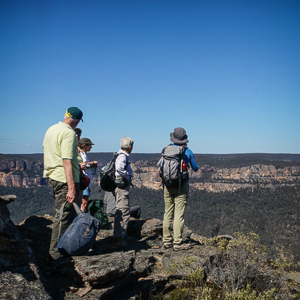Accessing places and objects of Aboriginal Significance
Introduction
The Upper Blue Mountains Bushwalking Club acknowledges the original inhabitants of the lands where many of our activities take place. While the Darug and Gundungurra peoples are acknowledged locally, the Greater Blue Mountains World Heritage Area was also the traditional homeland of the Wiradjuri, Wanaruah, Darkinjung and Tharawal groups.
Australian Aboriginal culture is the longest continuing culture in the world. Aboriginal peoples have lived on this continent for thousands of generations and the lands and waters have sustained their many unique cultures and economies. For Aboriginal people, the lands, waters and all living things are connected and the landscape is a living entity.
Traditions of knowledge sharing and learning have taken place and continue to take place on this land since the time of the Ancestors and the Dreaming. Culture. Customs, spirituality, language and Dreaming are embedded within the landscape and life of this land.
Aboriginal cultural heritage consists of places, traditions, beliefs, customs, values and objects that represent the living history of past generations and are of important cultural and heritage significance to Aboriginal people.
Guidelines
As with everyone who encounters an Aboriginal site, artefact, tool or anything else that is considered to be of Aboriginal Cultural significance, our members are asked to adhere to the following general principles.
- Activity leaders are encouraged to identify the Aboriginal people on whose land the activity is taking place and sign into country as follows: ‘’We would like to acknowledge the (… people) who were the traditional custodians caring for this land for more than 60,000 years, and we also pay our respect to Elders both past, present and emerging who continue to care for this country.”
- Never touch or walk on any rock art or engravings.
- Do not advertise the location of Aboriginal sites or artefacts on public forums/social media etc.
- If you find or believe you have found an Aboriginal object, leave it where it is and report the object and its location by emailing: ahims@environment.nsw.gov.au.
- If you have found an Aboriginal object or site specifically within Blue Mountains National Parks contact the Blue Mountains NPWS Head Office on ph:4784 7300 and provide the location and your details and it will be forwarded to the appropriate team to follow up internally.
- Do not leave log books in shelters with art or at any other Aboriginal sites as Aboriginal people still walk their Country and finding bushwalking logbooks at their sites is seen to be disrespectful.
- Never remove or damage objects of cultural significance. If you are not sure if an object, place or form of nature is significant – best practice is to observe all country as sacred.
This Policy
The scope of this policy is to add a local layer to the existing framework established by local, state and federal governments aimed at protecting Aboriginal cultural heritage. Aboriginal peoples’ definition of culture is not limited to particular places or physical evidence of Aboriginal existence on the land. It includes both the tangible and intangible things that tell a story about the land, environment, people, family, history, law, community and spirituality. Underpinning the overall cultural perspective, this policy focuses specifically on how we respect places and objects encountered while bushwalking.
Places and Objects
An Aboriginal Place is an area of land that has special significance for Aboriginal people. It can have spiritual, historical, social, educational, natural resource use or other type of significance. These places range from small ceremonial sites to mountains and lagoons and have been identified all over NSW. When a significant place is declared an Aboriginal Place, it is protected under the National Parks and Wildlife Act 1974.
Many of us today walk in the Blue Mountains landscape where the physical signs of the Aboriginal way of life are still abundant. Examples include: rock shelters, rock engravings, middens, grinding grooves, charcoal drawings, artefacts, tools etc. Physical objects could also include items such as stone, wood and shell artefacts that were used to make tools, weapons and implements. They could include fish traps, stone arrangements, scarred or carved trees and sites of occupational fringe camps that still exist today. Such items provide historical information about aboriginal people's experiences, ways of life and relationships with the environment.
Heritage NSW refers to these objects as items of ‘moveable heritage’. These guidelines will help our members approach such places and effects of Aboriginal significance. It formalises an approach that most members already practice. That is to encourage a more informed outlook and to value traditional Aboriginal knowledge, spirituality and the signs that remain of this unique culture. The document is not intended to be a set of rules but some guidelines grounded in respecting the past and appreciating the present.
Our thanks to the following organisation/individuals for their input into these guidelines:
- Blue Mountains Aboriginal and Cultural Resource Centre
- Blue Mountains Heritage Centre (NPWS)
- Author and Historian, Dr Jim Smith
In summary
The above guidelines serve only as common-sense principles to observe when walking ‘’on country’’. Participants in our activities should always proceed as if we are walking on someone else’s land and respect the people, respect the country and respect the traditions. A greater awareness of the deep spiritual and cultural significance of the land and the connectedness of nature, can only enhance our own experience of the bush.
For further information on the Aboriginal Cultural Heritage Protection with NSW National Parks please refer to the NSW NPWS Act at https://www.legislation.nsw.gov.au/view/html/inforce/current/act-1974-080 and the NSW Heritage Website at https://www.heritage.nsw.gov.au/about-our-heritage/aboriginal-cultural-heritage-services/
Last Update: 20-Apr-2022
